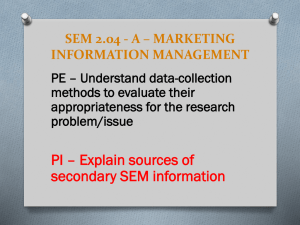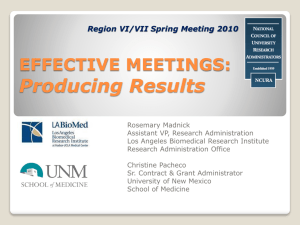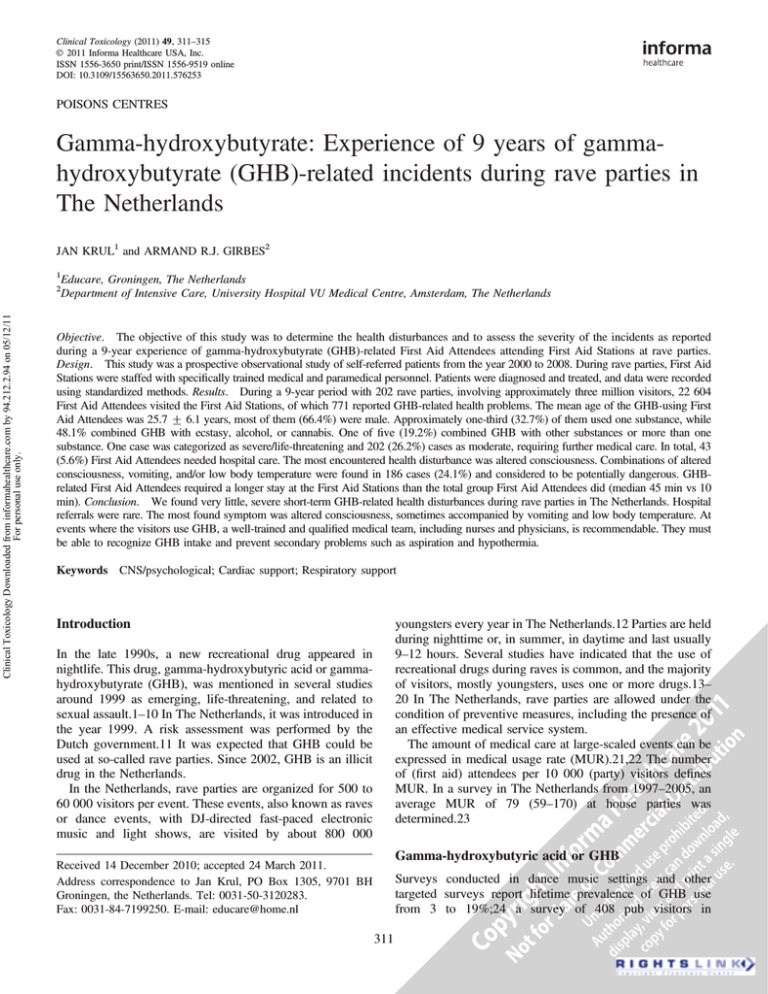
Clinical Toxicology (2011) 49, 311–315
Ó 2011 Informa Healthcare USA, Inc.
ISSN 1556-3650 print/ISSN 1556-9519 online
DOI: 10.3109/15563650.2011.576253
POISONS CENTRES
Gamma-hydroxybutyrate: Experience of 9 years of gammahydroxybutyrate (GHB)-related incidents during rave parties in
The Netherlands
JAN KRUL1 and ARMAND R.J. GIRBES2
1
Educare, Groningen, The Netherlands
Department of Intensive Care, University Hospital VU Medical Centre, Amsterdam, The Netherlands
Clinical Toxicology Downloaded from informahealthcare.com by 94.212.2.94 on 05/12/11
For personal use only.
2
Objective. The objective of this study was to determine the health disturbances and to assess the severity of the incidents as reported
during a 9-year experience of gamma-hydroxybutyrate (GHB)-related First Aid Attendees attending First Aid Stations at rave parties.
Design. This study was a prospective observational study of self-referred patients from the year 2000 to 2008. During rave parties, First Aid
Stations were staffed with specifically trained medical and paramedical personnel. Patients were diagnosed and treated, and data were recorded
using standardized methods. Results. During a 9-year period with 202 rave parties, involving approximately three million visitors, 22 604
First Aid Attendees visited the First Aid Stations, of which 771 reported GHB-related health problems. The mean age of the GHB-using First
Aid Attendees was 25.7 + 6.1 years, most of them (66.4%) were male. Approximately one-third (32.7%) of them used one substance, while
48.1% combined GHB with ecstasy, alcohol, or cannabis. One of five (19.2%) combined GHB with other substances or more than one
substance. One case was categorized as severe/life-threatening and 202 (26.2%) cases as moderate, requiring further medical care. In total, 43
(5.6%) First Aid Attendees needed hospital care. The most encountered health disturbance was altered consciousness. Combinations of altered
consciousness, vomiting, and/or low body temperature were found in 186 cases (24.1%) and considered to be potentially dangerous. GHBrelated First Aid Attendees required a longer stay at the First Aid Stations than the total group First Aid Attendees did (median 45 min vs 10
min). Conclusion. We found very little, severe short-term GHB-related health disturbances during rave parties in The Netherlands. Hospital
referrals were rare. The most found symptom was altered consciousness, sometimes accompanied by vomiting and low body temperature. At
events where the visitors use GHB, a well-trained and qualified medical team, including nurses and physicians, is recommendable. They must
be able to recognize GHB intake and prevent secondary problems such as aspiration and hypothermia.
Keywords CNS/psychological; Cardiac support; Respiratory support
Introduction
youngsters every year in The Netherlands.12 Parties are held
during nighttime or, in summer, in daytime and last usually
9–12 hours. Several studies have indicated that the use of
recreational drugs during raves is common, and the majority
of visitors, mostly youngsters, uses one or more drugs.13–
20 In The Netherlands, rave parties are allowed under the
condition of preventive measures, including the presence of
an effective medical service system.
The amount of medical care at large-scaled events can be
expressed in medical usage rate (MUR).21,22 The number
of (first aid) attendees per 10 000 (party) visitors defines
MUR. In a survey in The Netherlands from 1997–2005, an
average MUR of 79 (59–170) at house parties was
determined.23
In the late 1990s, a new recreational drug appeared in
nightlife. This drug, gamma-hydroxybutyric acid or gammahydroxybutyrate (GHB), was mentioned in several studies
around 1999 as emerging, life-threatening, and related to
sexual assault.1–10 In The Netherlands, it was introduced in
the year 1999. A risk assessment was performed by the
Dutch government.11 It was expected that GHB could be
used at so-called rave parties. Since 2002, GHB is an illicit
drug in the Netherlands.
In the Netherlands, rave parties are organized for 500 to
60 000 visitors per event. These events, also known as raves
or dance events, with DJ-directed fast-paced electronic
music and light shows, are visited by about 800 000
Gamma-hydroxybutyric acid or GHB
Received 14 December 2010; accepted 24 March 2011.
Address correspondence to Jan Krul, PO Box 1305, 9701 BH
Groningen, the Netherlands. Tel: 0031-50-3120283.
Fax: 0031-84-7199250. E-mail: educare@home.nl
Surveys conducted in dance music settings and other
targeted surveys report lifetime prevalence of GHB use
from 3 to 19%;24 a survey of 408 pub visitors in
311
Clinical Toxicology Downloaded from informahealthcare.com by 94.212.2.94 on 05/12/11
For personal use only.
312 J. Krul & A.R.J. Girbes
Amsterdam conducted in 2005 reported lifetime prevalence
of 10%. However, evidence suggests a niche market for
GHB, where use is concentrated in very specific subpopulations. Among respondents sampled in Amsterdam bars
frequented by gay men, the prevalence estimates for GHB
use rose to 17.5%, and in the city’s trendy bars up to 19%
compared to less than 5% among respondents in the more
mainstream or student pubs.
A Dutch survey conducted in 2001 among 72 GHB users
reported that three quarters of the respondents used GHB at
least once a month in the past year, and 50% of them had
taken it at least once a week. GHB was mostly taken in
combination with other substances.25
In 2008/2009, the use of substances was investigated
among parties and festivals. For GHB, lifetime prevalence
of 14% was found. Three percent of all visitors used GHB,
but great differences were found between parties (range
0–20%).20
The objective of this study was to determine the health
disturbances and to assess the severity of the incidents
as reported during a 9-year experience of GHB-related
First Aid Attendees attending First Aid Stations at rave
parties.
Methods
Design and participants
A prospective observational study of self-referred patients
who reported to an available First Aid Station (First Aid
Station) during Dutch rave parties was conducted. All users
of medical care were registered, but only those with GHBrelated problems were included in this study.
A standard registration questionnaire was developed to
gather the reported health problems. Part of the information
that was collected included the type and the number of
substances that were used as well as contributory health
complaints. All cases were scored on a two-dimension level.
Incidents were categorized as medical, trauma, psychological, or miscellaneous (Table 1). Next to these categories,
each incident was classified as mild (defined as absence
of professional medical care), moderate (defined as
professional medical care required), or severe (defined as
life-threatening), based on the Severity Index.26
Qualified nurses, paramedics, and physicians, all with
additional specific training on party-related risks, including
effects of recreational drugs, examined the patients. Of all
First Aid Attendees, level of consciousness and body
temperature were measured. Members of staff of the First
Aid Station were trained in using the questionnaire as well in
an introduction course and a yearly refresher and update
course. A colleague, who was especially appointed to support
the staff in filling out the questionnaires, coached all staff
members. Mistakes and inconsistencies were corrected on
scene.
The number of visitors was obtained from the organizers
of the events (total number of sold tickets).
Procedure
After entering the First Aid Station, the attendee was
received by a front desk officer, who asked the patient
about his complaint, injury, or question. Some visitors
attended the First Aid Station for self-treatment; they
asked to get a band-aid to avoid blisters or asked for a
painkiller to relieve their headache, and therefore were not
assessed as a medical problem. All other attendees were
transferred to a member of the medical staff, who
assessed the health problems. All data were registered in
the standard questionnaire.
After discharge from the First Aid Station or transfer to
ambulance personnel for hospital transport, a staff member
who was especially assigned to verify the registration
checked all data on the questionnaire. This official also
classified the incident as mild, moderate, or severe and
categorized it as medical, trauma, psychological, or miscellaneous.
Statistics
Descriptive statistics were used. For comparison of
nonparametric data, Mann–Whitney U-test was used,
whereas for normally distributed data, a Student’s t-test
was used. A p-value of 50.05 was considered significant.
All analyses were performed using SPSS version 17.0
(SPSS Inc).
Table 1. Categorized health problems.
Category
Definition
Medical
General medical complaints or health
disturbances
Trauma
Local injuries
Psychological
Miscellaneous
Psychological and psychiatric symptoms
A combination of medical, trauma, and/or
psychological, or not fitting in other
categories
Questionnaire items
General unwell-being/fainting, nausea, vomiting, dizziness,
altered consciousness, palpitations, altered body temperature,
stomach ache, hyperventilation, dyspnea, and cramps
Wound/laceration, burn, blister/skin injury, contusion,
distortion, fracture, tooth injury, insect bite or stitch, nail
problem, foreign body, and local inflammation
Anxiety, disorientation, psychotic delusion, and agitation
Clinical Toxicology vol. 49 no. 4 2011
GHB-related incidents in The Netherlands 313
failure), while 55 cases (21.8%) scored moderate on the
Emergency Severity Index.26 The severe case concerned a
43-year-old man with a pre-existing trachea aberration.
Endotracheal intubation failed on scene. The patient was
discharged from the hospital after only 2 days.
Most First Aid Attendees using only GHB (67.7%)
suffered from mild problems. In First Aid Attendees who
combined use of GHB with other substances (N ¼ 519), no
life-threatening cases were found. In total, 147 First Aid
Attendees (28.3%) were classified as moderate severity
(Table 3).
Most occurring health disturbances of First Aid Attendees
using only GHB were altered consciousness (56.0%),
followed by general unwell-being (34.5%), low body
temperature (22.2%), vomiting (17.5%), disorientation
(8.7%), and dizziness (7.1%). Other reported symptoms
were cramps and agitation (both 2.0%); trauma (1.4%);
anxiety, gastric pain, high body temperature, and psychotic
delusion (all 0.8%); and stomach ache (0.4%).
Of all 87 GHB-related cases of altered consciousness,
half of them scored lower than eight on the Glasgow
Coma Scale (GCS) on the range of 3–14 (Fig. 1). With 54
cases, altered consciousness was also found, but the GCSscore remained unknown. In 56 (7%) cases using
GHB, low body temperature (536.6 C) was found. No
case of severe hypothermia (532 C) was seen. One case
was classified as moderate and 24 cases as mild
hypothermia.
Clinical Toxicology Downloaded from informahealthcare.com by 94.212.2.94 on 05/12/11
For personal use only.
Results
Demographics
A summary of all rave parties included in this study is in
Table 2. Data from 202 events, totaling approximately three
million visitors and 22 604 First Aid Attendees, were
collected. Mean age was 22.3 + 5.4 years. The male/female
ratio was 52.4/47%. Of all First Aid Attendees, an average
of 32.9% suffered from a substance-related health disturbance.
In total, 771 attendees visited the First Aid Station after the
use of GHB. Mean age was 25.7 + 6.1 years. Approximately
two-third (66.4%) of them were male. Median stay at the
First Aid Station was 45 min and significantly longer than the
median stay of the total group of First Aid Attendees, which
was 10 min (n ¼ 22 604, p 5 0.001).
Of all GHB-using First Aid Attendees, 252 (32.7%)
attendees used GHB only (one substance), 190 (24.6%)
combined GHB with ecstasy, 123 (15.6%) with alcohol, and
61 (7.9%) with cannabis. The remaining 145 persons
(18.8%) combined GHB with other substances, such as
amphetamine (2.3%) or cocaine (0.8%), or more than one
other substance. In total, 97 (12.6%) First Aid Attendees
used a combination of GHB, ecstasy, and alcohol.
Clinical features
One of 252 cases of First Aid Attendees using only GHB
was categorized as severe/life-threatening (respiratory
Table 2. Party characteristics, medical usage rate, and substance-related First Aid Station visits.
Year
Parties
2000
2001
2002
2003
2004
2005
2006
2007
2008
14
29
26
35
33
33
10
13
9
Party visitors
226
420
466
476
453
455
265
297
252
First Aid Attendees
MUR*
1843
3629
2971
3337
3818
2690
1249
1600
1467
81
86
64
70
84
59
47
54
58
500
500
000
750
500
750
000
000
000
Substance-related visits{(%)
670
1371
1109
1135
1166
914
351
444
442
(36.4)
(37.8)
(37.3)
(34.0)
(30.5)
(34.0)
(28.1)
(27.8)
(30.1)
* MUR, Medical Usage Rate – amount of First Aid Attendees per 10 000 party visitors.
{ Percentage of the First Aid Attendees.
Table 3. Severity index and classifications of GHB-related health problems and of problems with GHB combined with other substances.
GHB alone (N ¼ 252)
Medical
Trauma
Psychiatric
Miscellaneous
Severe*
Moderate{
0.4% (1)
0
0
0
20.2% (51)
0
0.4% (1)
1.2% (3)
* Life-threatening.
{ Not life-threatening, but professional medical care required.
{ Absence of professional medical care.
Clinical Toxicology vol. 49 no. 4 2011
GHB plus other substances (N ¼ 519)
Mild{
64.7%
0.4%
1.2%
11.4%
(163)
(1)
(3)
(29)
Severe
0
0
0
0
Moderate
25.2%
0.2%
1.0%
1.9%
(131)
(1)
(5)
(10)
Mild
60.5% (314)
0.8% (4)
2.1% (11)
5.45 (28)
314 J. Krul & A.R.J. Girbes
Clinical Toxicology Downloaded from informahealthcare.com by 94.212.2.94 on 05/12/11
For personal use only.
Fig. 1. Cases of GHB-related altered consciousness with GCS515
(N ¼ 141, median ¼ 8, and range ¼ 12).
Treatment and clinical referrals
Most First Aid Attendees were treated at the First Aid
Station. Three persons (0.4%) were referred to their family
doctor, and 43 (5.5%) patients were transported to the
hospital emergency department, because of persevering
altered consciousness and potentially threatened airway.
Discussion
During 9 years of experience at rave parties with over
three million visitors, 771 First Aid Attendees (3.4% of all
Fist Aid Attendees) who used GHB were seen at the First
Aid Station on scene. Compared to other substance-related
problems, this is indeed a very low number of cases. In
a 9-year lasting study among rave party visitors, most
substance-related health disturbances of First Aid Attendees were related to ecstasy (21.8%) and alcohol
(16.1%).23
In 23.6% of the GHB-using First Aid Attendees, serious
symptoms such as altered consciousness were present. One
severe case of respiratory failure was presented, requiring
short-term hospital stay and mechanical ventilation. No
GHB-related mortality was observed.
GHB is frequently used in combination with other party
drugs. This implies that in case of patients with suspected
GHB-related symptoms, the likelihood of other drugs
involved should be taken into account. However, in our
series, no differences in severity of symptoms were found in
First Aid Attendees using only GHB vs those who used
GHB in combination with other substance(s). But patients
with GHB-related problems require a longer stay in the First
Aid station than other First Aid Attendees. Accidental
hypothermia is a potentially dangerous condition and can
easily be overlooked. Our observation of the present
combination of altered consciousness, vomiting, and
hypothermia underscores the importance of systematic
examination of First Aid Attendees suspected of GHBrelated symptoms. Instruction and training of staff involved
in medical assistance during rave parties should therefore
focus on these symptoms, using appropriate protocols. It is
of note that this combination of conditions is underreported
in the current literature.25,27–30
Interestingly, the majority of First Aid Attendees with
GHB-related complaints did not require hospital care: the
supportive care of First Aid Stations with appropriately
trained staff was sufficient to deal with most encountered
problems.
Some symptoms, such as general unwell-being, nausea,
and dizziness, were likely not GHB-specific. It is conceivable that some of the rave visitors developed these
complaints after a 6–12-hour lasting event, because of
tiredness and dehydration.
Questions remain as to whether the relatively low rate of
severe incidents is related to the open and legal circumstances under which rave parties take place in The
Netherlands. It is not unlikely to assume that an open and
easy access to medical facilities during rave parties
encourages early recognition of complaints and thereby
more health-promoting behavior (disease-limiting behavior)
in visitors of rave parties. Data from The Netherlands can,
therefore, not be extrapolated automatically to other
countries, where rave parties with party drugs take place
in more or less hidden and secret conditions. It would,
therefore, be of interest to investigate the incidence of
health-related problems during rave parties in other
countries. It will, however, by definition be difficult to
compare data of different countries with different legislation
and medical infrastructure during rave parties. To our
knowledge, no publications on GHB-related cases during
large-scaled events at First Aid Station are available at this
time.
Limitations of the study
Long-term effects of substance use or drug addiction were
not investigated and remain, therefore, unknown. Other
limitations of this study include that although the sample is
large, it only includes self-referrals and does not necessarily
provide a complete overview of all GHB-related disturbances at rave parties. It is possible that a number of persons
suffered from complaints, but did not visit the First Aid
Station. Wijngaart et al and de Bruin et al found that some
party visitors sought help with friends, security personnel, or
catering staff.18,19,31 Furthermore, some visitors with
health complaints may have gone directly to their general
practitioner or a hospital emergency room, instead of
attending the on-scene First Aid Station.
In some cases, the questionnaire was not filled in
accurately. Specifically, for 54 cases, altered consciousness
was reported, but no score on the GCS was given.
No biological confirmation of the substance intake by
toxic screening of urine or blood was done. We have not
measured to what the attendees were exposed to, quantitatively or qualitatively. We only know what they voluntarily
reported. Next to this, substance use may have been
underestimated related to stigmatization or fear of law
enforcement.
Clinical Toxicology vol. 49 no. 4 2011
GHB-related incidents in The Netherlands 315
Conclusions
We found very little severe short-term GHB-related health
disturbances during rave parties in The Netherlands.
Hospital referrals were rare. Most found symptom was
altered consciousness, sometimes accompanied by vomiting
and low body temperature.
At events where the visitors use GHB, a well-trained and
qualified medical team including nurses and physicians is
recommendable. They must be able to recognize GHB
intake and prevent secondary problems such as aspiration
and hypothermia.
Clinical Toxicology Downloaded from informahealthcare.com by 94.212.2.94 on 05/12/11
For personal use only.
Declaration of interest
The author reports no conflicts of interest. The author alone
is responsible for the content and writing of the paper.
References
1. Munir V, Hutton J, Harney J, Buykx P, Weiland T, Dent A. Gammahydroxybutyrate: a 30 month emergency department review. Emerg
Med Australas 2008; 20:521–530.
2. Williams H, Taylor R, Roberts M. Gamma-hydroxybutyrate (GHB): a
new drug of misuse. Ir Med J 1998; 91:56–57.
3. Hodges B, Everett J. Acute toxicity from home-brewed gamma
hydroxybutyrate. J Am Board Fam Pract 1998; 11:154–157.
4. Ryan JM, Stell I. Gamma hydroxybutyrate – a coma inducing
recreational drug. J Accid Emerg Med 1997; 14:259–261.
5. James C. Another case of gamma hydroxybutyrate (GHB) overdose. J
Emerg Nurs 1996; 2297.
6. Ross TM. Gamma hydroxybutyrate overdose: two cases illustrate the
unique aspects of this dangerous recreational drug. J Emerg Nurs
1995; 21:374–376.
7. Graeme KA. New drugs of abuse. Emerg Med Clin North Am 2000;
18:625–636.
8. Eckstein M, Henderson S, DelaCruz P, Newton E. Gamma
hydroxybutyrate (GHB): report of a mass intoxication and review of
the literature. Prehosp Emerg Care 1999; 3:357–361.
9. ElSohly M, Salamone S. Prevalence of drugs used in cases of alleged
sexual assault. J Anal Toxicol 1999; 23:141–146.
10. Kam P, Yoong F. Gamma-hydroxybutyric acid: an emerging
recreational drug. Anaesthesia 1998; 53:1195–1198.
11. Keizer ADJ, Scholten WK, Lousberg RJJC, Kustner B, Knaack F,
Spruit IP, et al. Risicoschattingsrapport betreffende gammahydroxybutyraat (GHB). Den Haag: IGZ; 1999.
12. Gram H, Jongedijk S, Olthof S, Reinders A, van Schubert D. Dance in
Nederland. De betekenis en impact van dance op de Nederlandse
economie en maatschappij: Een verkenning. KPMG: Amstelveen; 2002.
13. Abraham MD, Kaal HL, Cohen PDA. Licit and Illicit Drug Use in
The Netherlands 2001. Amsterdam: Cedro/Mets & Schilt; 2002.
Clinical Toxicology vol. 49 no. 4 2011
14. Engels RC, ter Bogt T. Outcome expectancies and ecstasy use in
visitors of rave parties in the Netherlands. Eur Addict Res 2004;
10:156–162.
15. Pijlman FTA, Krul J, Niesink RJM. Uitgaan en veiligheid: feiten en
fictie over alcohol, drugs en gezondheidsverstoringen. Utrecht:
Trimbos; 2003.
16. ter Bogt TFM, Engels RCME. Partying hard: party style,
motives for and effects of MDMA use at rave parties. Subst Use
Misuse 2005; 40:1479–502.
17. ter Bogt TFM, Engels RCME, Dubas JS. Party people: personality
and MDMA use of house party visitors. Addict Behav 2006;
31:1240–1244.
18. van de Wijngaart GF, Braam R, de Bruin D, Fris M, Maalste´ N,
Verbraeck H. Ecstacy in het uitgaanscircuit. Utrecht: CVO; 1997.
19. van de Wijngaart GF, Braam R, de Bruin D, Fris M, Maalste NJM,
Verbraeck HT. Ecstasy use at large-scale dance events in the
Netherlands. J Drug Issues 1999; 29:679–702.
20. van der Poel A, Doekhie J, Verdurmen J, Wouters M, Korf DJ,
van Laar M. Feestmeter 2008–2009. Uitgaan en middelengebruik
onder bezoekers van party’s en clubs. Utrecht: Trimbos-instituut;
2010.
21. Milsten AM, Maguire BJ, Bissel RA, Seaman KG. Mass-gathering
medical care: a review of the literature. Prehospital Disast Med 2002;
17:151–162.
22. Milsten AM, Seaman KG, Liu P, Bissel RA, Maguire BJ.
Variables influencing medical usage rates, injury patterns, and
levels of care for mass gatherings. Prehospital Disast Med 2003;
18:334–346.
23. Krul J, Girbes ARJ. Experience of health-related problems during
house parties in the Netherlands: nine years of experience and three
million visitors. Prehospital Disast Med 2009; 24:133–139.
24. Nabben T, Benschop A, Korf DJ. Antenne 2005: Trends in Alcohol,
tabak en drugs bij jonge Amsterdammers. Amsterdam: Rozenberg;
2006.
25. Korf DJ, Nabben T, Leenders F, Benschop A. GHB: Tussen Extase en
Narcose. Amsterdam: Rozenberg; 2002.
26. de Boer J. Rampengeneeskunde. Een samenvattend overzicht.
Spoedeisende en rampengeneeskunde. Amsterdam: VU Uitgeverij;
2001. pp 179–191
27. Bodson Q, Denooz R, Serpe P, Charlier C. Gamma-hydroxybutyric
acid (GHB) measurement by GC-MS in blood, urine and gastric
contents, following an acute intoxication in Belgium. Acta Clin Belg
2008; 63:200–208.
28. Degenhardt L, Darke S, Dillon P. GHB use among Australians:
characteristics, use patterns and associated harm. Drug Alcohol
Depend 2002; 67:89–94.
29. Galicia M, Nogue S, To-Figueras J, Echarte JL, Iglesias ML, Miro O.
Poisoning by liquid ecstasy (GHB) in hospital emergency
departments of Barcelona: a 2-years study. Med Clin (Barc) 2008;
130:254–258.
30. Sporer KA, Chin RL, Dyer JE, Lamb R. Gamma-hydroxyburate
serum levels and clinical syndrome after severe overdose. Annals
Emerg Med 2003; 42.
31. de Bruin D, Maalste NJM, van de Wijngaart GF. Goed fout gaan.
Eerste hulp op grote dansevenementen. Utrecht: CVO; 1998.



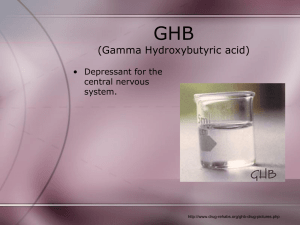
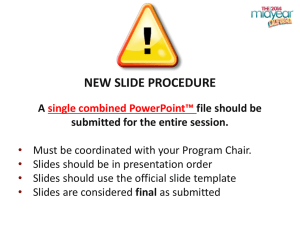
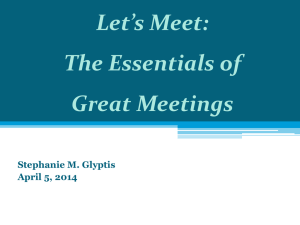
![SEM_1_-_2.03-2.04_and_2.06_PPT[1]](http://s2.studylib.net/store/data/005412429_2-ee09ccc3ae8bb5a8455b0fdbcc5543ae-300x300.png)

